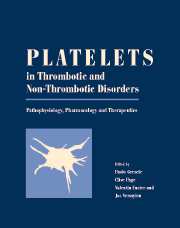Book contents
- Frontmatter
- Contents
- List of contributors
- Editors' preface
- PART I PHYSIOLOGY
- 1 History of platelets
- 2 Production of platelets
- 3 Morphology and ultrastructure of platelets
- 4 Platelet heterogeneity: physiology and pathological consequences
- 5 Platelet membrane proteins as adhesion receptors
- 6 Dynamics of the platelet cytoskeleton
- 7 Platelet organelles
- 8 Platelet receptors for thrombin
- 9 Platelet receptors: ADP
- 10 Platelet receptors: prostanoids
- 11 Platelet receptors: collagen
- 12 Platelet receptors: von Willebrand factor
- 13 Platelet receptors: fibrinogen
- 14 Platelet signalling: GTP-binding proteins
- 15 Platelet phospholipases A2
- 16 Roles of phospholipase C and phospholipase D in receptor-mediated platelet activation
- 17 Platelet signalling: calcium
- 18 Platelet signalling: protein kinase C
- 19 Platelet signalling: tyrosine kinases
- 20 Platelet signalling: cAMP and cGMP
- 21 Platelet adhesion
- 22 The platelet shape change
- 23 Aggregation
- 24 Amplification loops: release reaction
- 25 Amplification loops: thromboxane generation
- 26 Platelet procoagulant activities: the amplification loops between platelets and the plasmatic clotting system
- 27 Platelets and chemotaxis
- 28 Platelet–leukocyte interactions relevant to vascular damage and thrombosis
- 29 Vascular control of platelet function
- PART II METHODOLOGY
- PART III PATHOLOGY
- PART IV PHARMOLOGY
- PART V THERAPY
- Afterword: Platelets: a personal story
- Index
- Plate section
20 - Platelet signalling: cAMP and cGMP
from PART I - PHYSIOLOGY
Published online by Cambridge University Press: 10 May 2010
- Frontmatter
- Contents
- List of contributors
- Editors' preface
- PART I PHYSIOLOGY
- 1 History of platelets
- 2 Production of platelets
- 3 Morphology and ultrastructure of platelets
- 4 Platelet heterogeneity: physiology and pathological consequences
- 5 Platelet membrane proteins as adhesion receptors
- 6 Dynamics of the platelet cytoskeleton
- 7 Platelet organelles
- 8 Platelet receptors for thrombin
- 9 Platelet receptors: ADP
- 10 Platelet receptors: prostanoids
- 11 Platelet receptors: collagen
- 12 Platelet receptors: von Willebrand factor
- 13 Platelet receptors: fibrinogen
- 14 Platelet signalling: GTP-binding proteins
- 15 Platelet phospholipases A2
- 16 Roles of phospholipase C and phospholipase D in receptor-mediated platelet activation
- 17 Platelet signalling: calcium
- 18 Platelet signalling: protein kinase C
- 19 Platelet signalling: tyrosine kinases
- 20 Platelet signalling: cAMP and cGMP
- 21 Platelet adhesion
- 22 The platelet shape change
- 23 Aggregation
- 24 Amplification loops: release reaction
- 25 Amplification loops: thromboxane generation
- 26 Platelet procoagulant activities: the amplification loops between platelets and the plasmatic clotting system
- 27 Platelets and chemotaxis
- 28 Platelet–leukocyte interactions relevant to vascular damage and thrombosis
- 29 Vascular control of platelet function
- PART II METHODOLOGY
- PART III PATHOLOGY
- PART IV PHARMOLOGY
- PART V THERAPY
- Afterword: Platelets: a personal story
- Index
- Plate section
Summary
History
The first report that cyclic AMP had an effect on platelets came from Marcus and Zucker, who showed that dibutiryl cyclic AMP, a cell permeant cyclic AMP analogue, inhibited platelet aggregation. Ardlie et al. showed that methyl xanthines, which inhibit cyclic AMP phosphodiesterase and hence elevate cyclic AMP levels, also inhibit platelet aggregation and proposed that cyclic AMP is an important mediator of platelet function. In 1969, several groups of investigators reported that the level of platelet cyclic AMP regulated platelet function and showed that both platelet agonists and antagonists could affect the intraplatelet concentration of cyclic AMP. Salzman suggested that cyclic AMP might be the ultimate mediator of platelet activation in that agents that inhibited aggregation increased cyclic AMP, while agents that activated platelets did so by lowering the basal level of cyclic AMP. However, the idea that agonists activate platelets by lowering basal cyclic AMP was convincingly refuted by Haslam et al.
Elevated levels of cyclic GMP also inhibit platelet activation and platelet activators elevate cyclic GMP. However, the latter effect has been shown to be a consequence of aggregation and does not occur during other forms of platelet activation. A schematic summary of the information in this review is shown in Fig. 20.1.
Platelet receptors coupled to adenylyl cyclase activation
Prostaglandins that elevate cyclic AMP levels are potent inhibitors of platelet activation. Adenosine acts through the A2A receptor to activate adenylyl cyclase.
- Type
- Chapter
- Information
- Platelets in Thrombotic and Non-Thrombotic DisordersPathophysiology, Pharmacology and Therapeutics, pp. 290 - 303Publisher: Cambridge University PressPrint publication year: 2002
- 5
- Cited by



